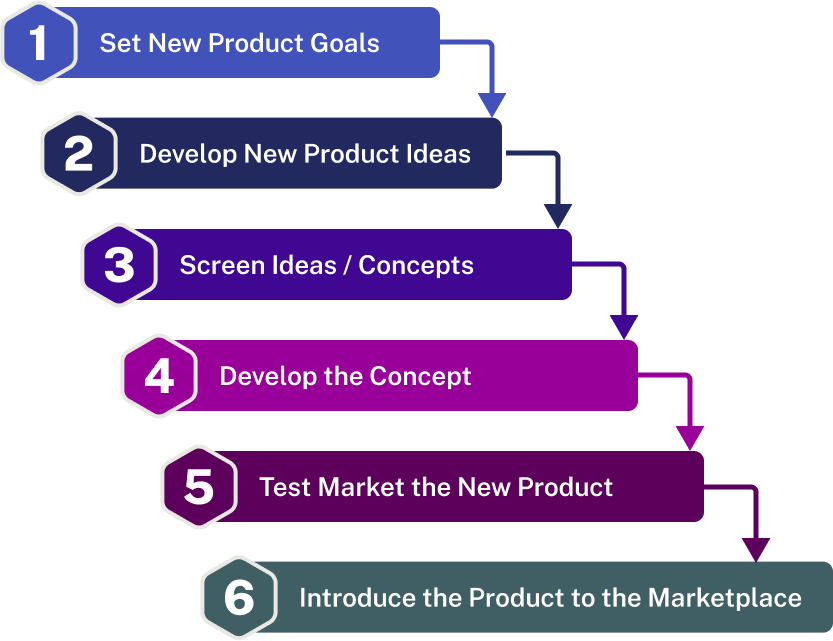New Product Development
Developing new products is both costly and risky, especially for companies that sell products that are goods. New-product failure rates for household and grocery products can approach 80 percent. Overall, companies report that only 3 percent of their products exceed their initial sales targets in Year 1. Industrial goods failure rates tend to be lower than those for consumer goods. To increase their chances for success, most businesses use a product development process which is summarized below.

Set New-Product Goals
New-product goals are usually stated as financial objectives. For example, a company may want to recover its investment in three years or less. Or it may want to earn at least a 15 percent return on the investment. Nonfinancial goals may include using existing equipment or facilities.
Develop New-Product Ideas
Smaller firms usually depend on employees, customers, investors, and distributors for new ideas. Larger companies use these sources and more structured marketing research techniques, such as focus groups and brainstorming. A focus group consists of eight to 12 participants led by a moderator in an in-depth discussion on one particular topic or concept. The goal of focus group research is to learn and understand what people have to say and why. The emphasis is on getting people to speak at length and in detail about the subject at hand. The intent is to find out how they feel about a product, concept, idea, or organization; how it fits into their lives; and their emotional involvement with it. Focus groups often generate excellent product ideas. A few examples of focus group influenced products are the interior design of the Toyota RAV4, Stick Ups room deodorizers, Swiffer WetJet, and Wendy’s Salad Sensations. In the business market, machine tools, keyboard designs, aircraft interiors, and backhoe accessories evolved from focus groups.
Brainstorming is also used to generate new-product ideas. With brainstorming, the members of a group think of as many ways to vary a product or solve a problem as possible. Criticism is avoided, no matter how ridiculous an idea seems at the time. The emphasis is on sheer numbers of ideas. Evaluation of these ideas is postponed to later steps of development.
Screen Ideas and Concepts
As ideas emerge, they are checked against the firm’s new-product goals and its long-range strategies. Many product concepts are rejected because they don’t fit well with existing products, needed technology is not available, the company doesn’t have enough resources, or the sales potential is low.
Develop the Concept
Developing the new-product concept involves creating a prototype of the product, testing the prototype, and building the marketing strategy. Building the marketing strategy means developing a test set of 4Ps. The type and amount of product testing varies, depending on such factors as the company’s experience with similar products, how easy it is to make the item, and how easy it will be for consumers to use it.
If The Kraft Heinz Company wanted to develop a new salad dressing flavor, the company would benefit from the fact that it already has a lot of experience in this area with their Kraft Salad Dressing brand. The new dressing will go directly into advanced taste tests and perhaps home-use tests. To develop a new line of carbonated beverages, a product not currently offered in any of its brands, it would most likely do a great deal of of research and testing before actually making it.
While the product is tested, the marketing strategy is refined. Channels of distribution are selected, pricing policies are developed and tested, the target market is further defined, and demand for the product is estimated. Management also continually updates the profit plan. As the marketing strategy and prototype tests mature, a communication strategy is developed. A logo and package wording are created. As part of the communication strategy, promotion themes are developed, and the product is introduced to the sales force.
Test-Market the New Product
Test-marketing involves selling a product for a limited time and in limited places to reach potential users. It allows management to evaluate various strategies and to see how well the parts of the marketing mix fit together. Companies that don’t test-market their products run a strong risk of product failure. The product is put into the marketplace, and then the manufacturer can see how it performs against the competition. Few new-product concepts reach this stage. For those that pass this stage, the firm must decide whether to introduce the product on a regional or national basis.
Introduce the Product
A product that passes test-marketing is ready for market introduction, called rollout, which requires a lot of logistical coordination. Various divisions of the company must be encouraged to give the new item the attention it deserves. Packaging and labeling in a different language may be required. Sales training sessions must be scheduled, spare parts inventoried, service personnel trained, advertising and promotion campaigns readied, and wholesalers and retailers informed about the new item. If the new product is to be sold internationally, it may have to be altered to meet the requirements of the target countries. For instance, electrical products may have to run on different electrical currents.